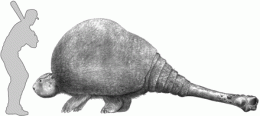August 27, 2009 weblog
Extinct Mammal Used its 'Sweet Spot' to Club Rivals

(PhysOrg.com) -- Scientists in Uruguay studying extinct mammals called glyptodonts have discovered they used a "sweet spot" in their tails, just like baseball players use the center of percussion (CP), or sweet spot, in their bats to hit the ball with maximum power and minimum chance of injury.
Glyptodonts lived in the late Eocene to the early Holocene, spreading northwards from South America, and becoming extinct some 8-11,000 years ago. They were heavily armored giants resembling armadillos, and they were equipped with a lethal tail with a spiked club at the end.
The new research, published in the Proceedings of the Royal Society B, studied several species of glyptodonts. Leader of the team, Dr R. Ernesto Blanco, said the research was inspired by earlier studies of sports equipment such as golf clubs and baseball bats, which calculated the position of the center of percussion (CP) or sweet spot on the sports tool. As any baseball hitter will tell you, you get the best results if you hit the ball at the bat's sweet spot since this delivers maximum power, but produces the least amount of force in the athlete's wrist and arm, reducing the chance of injury.
Blanco and his colleagues Washington W. Jones, and Andres Rinderknecht, decided to use the same methods as the sports studies to determine the location of the sweet spot on the tails of the glyptodonts. They studied fossilized remains of glyptodonts in the collections of three South American museums, and found that in many species of glyptodonts, such as Doedicurus clavicaudatus, the ball of bony plates at the end of the tail was located at the center of percussion.
The plates were fused, turning the tail into a rigid weapon that concentrated the force onto the sweet spot in the tail's club, which is believed to have been covered in large horny spikes. The scientists likened the flexible part of the glyptodont's tail to a tennis player's arm, and the rigid club at the end of the tail to the tennis racket, with the sweet spot under the largest spikes.
Having the sweet spot in the position of the largest spikes meant the glyptodont tail clubs must have been extremely effective weapons capable of inflicting damaging blows, but with minimal risk of injuring the vertebrae in the tail. Despite their huge size glyptodonts were pretty nimble creatures able to turn 180 degrees while standing on their hind legs and swinging their tails laterally at speeds of up to 49 feet per second.
The scientists believe the glyptodonts used their tails primarily against other glyptodonts in ritualized combats over territory and sexual mates. Possessing a spiked tail club was also undoubtedly useful for fighting off predators, such as South America's 650 pound terror birds, saber-toothed cats, and other giants, but the scientists' results suggest the tails were better suited to more stationary situations than fighting off fast predators.
More information: The sweet spot of a biological hammer: the centre of percussion of glyptodont (Mammalia: Xenarthra) tail clubs; Proc. R. Soc. B published online before print August 26, 2009, doi:10.1098/rspb.2009.1144
© 2009 PhysOrg.com


















